Embracing OT Cybersecurity as a Transformative Culture Shift

Building a resilient OT-IT integrated future requires vision and a proactive approach to cybersecurity.

TAKEAWAYS:
● Leaders need an outcome-focused cybersecurity vision that sets clear, strategic goals for what they want to achieve in terms of security and ensures that decisions and actions align with these outcomes.
● Take immediate action by integrating the SANS Five Critical Controls for Industrial Control Systems (ICS), the first lie of cybersecurity defense, offering a structured approach to incident response, network architecture, visibility, secure access, and vulnerability management.
● Stay one step ahead by proactively addressing the common attack vectors that target OT environments to enhance organizational resilience against cyberattacks and safeguard critical operations.
In modern manufacturing, the integration of Operational Technology (OT) with traditional IT systems has given rise to a new set of challenges. OT, which encompasses the hardware and software that monitors and controls physical devices, is the backbone of manufacturing operations. Yet, it is often the case that these systems were not designed with cybersecurity in mind, thereby creating an environment ripe for exploitation.
As manufacturers rely more on automated processes and connected devices, the line between IT and OT blurs, making it crucial to protect the entire ecosystem. Unlike traditional IT security, which focuses on safeguarding data, OT cybersecurity is about maintaining system integrity and ensuring the continuous, safe operation of production lines.
Recognizing the unique requirements of OT environments is the first step in securing them. These systems demand a specialized, OT-specific approach to cybersecurity. The approach must:
- understand the systems
- analyze and log the commands for threat behaviors or to spot misconfigurations
- consider the need for minimal disruption
- prioritize workforce and equipment safety
Understanding the Operational Risks in Manufacturing
The operational risks facing the manufacturing sector are multifaceted. The ramifications of a breach in an OT system can be far more severe than that of an IT system, often resulting in physical damage to equipment, downtime in production, loss of revenue, and even risks to human lives. As remote access into OT increases, risk to the environment increases with it.
Moreover, cybercriminals are constantly devising new methods to exploit vulnerabilities in OT systems. These adversaries range from money-motivated ransomware gangs to sophisticated criminal organizations and state-sponsored actors, all with the capability to disrupt manufacturing operations on a massive scale. The truly alarming aspect lies in the potential for advanced tools, developed by sophisticated nation states, to fall into the hands of less sophisticated adversaries. These adversaries, driven by financial motives, are willing to target any type of organization.
According to the recently released Dragos OT Cybersecurity Year in Review, ransomware attacks escalated by nearly 50% in 2023, with the manufacturing sector being the primary target.
The operational risks also extend to the supply chain, where a single vulnerability can have cascading effects across multiple manufacturers. Key software components can be a part of hundreds of different systems, impacting hundreds of thousands of devices, like PIPEDREAM – an industrial control systems (ICS)-specific malware toolkit. The interconnectivity of suppliers, vendors, and partners means that securing the manufacturing process is no longer just about protecting one’s own operations but ensuring the integrity of the entire value chain.
According to the recently released Dragos OT Cybersecurity Year in Review, ransomware attacks escalated by nearly 50% in 2023, with the manufacturing sector being the primary target. High-profile ransomware attacks on major companies like Dole, Boeing, and Clorox resulted in the shutdown of facilities and substantial financial losses. Lockbit ransomware alone accounted for 25% of all industrial ransomware attacks, with ALPHV and BlackBasta each contributing 9% of the total.
A pivotal insight from the report: approximately 70% of OT-related cyber incidents originated from the IT environment, indicating the need for robust network segmentation and separate domains for IT and OT systems.
The Need for a Cultural Shift in OT Cybersecurity
The crux of the challenge lies not just in the technology, but in the mindsets of teams operating and managing OT systems. For decades, the primary focus of manufacturing has been on efficiency and productivity, with cybersecurity often taking a backseat. This must change. Industry must foster a culture where cybersecurity is as fundamental as safety and quality.
Embracing OT cybersecurity requires a cultural shift within the organization, where everyone from the shop floor to the boardroom understands the significance of cybersecurity and their role in upholding it. This shift entails a move away from reactive measures toward a proactive approach that can also be used to increase operational equipment efficiency (OEE) and resilience.
Adopting an outcome-focused mindset ensures that the organization remains resilient against emerging threats, with a clear focus on achieving desired security outcomes.
A robust OT cybersecurity program encompasses the entire manufacturing process, with a focus on protecting the most vital assets. Although comprehensive frameworks like NIST and ISA/IEC 62443 exist to guide the development of a thorough plan, their complexity can sometimes hinder prompt action. Our recommendation is to start with the implementation of the SANS Five Critical Controls for ICS, which include:
- OT-Specific Incident Response Plan
- Defensible Architecture
- ICS Network Visibility & Monitoring
- Secure Remote Access
- Risk-Based Vulnerability Management
Begin by putting these controls into practice, ensuring they are fully operational and can efficiently handle key scenarios. As the program evolves, establish a risk management framework. This will allow the program leader to fine-tune investments and enhance risk mitigation efforts.
The Impact of Cyber Controls on Operational Efficiency
It is crucial to recognize that implementing the right cyber controls can lead to substantial improvements in operational efficiency and uptime. In production environments, the questions of “What happened and why?” are frequently posed. While some answers may be straightforward, identifying the root cause of emergent problems often proves challenging. Controls that enable the identification of new devices, monitor third-party remote access, and log OT system commands offer a valuable data set. This data can be analyzed to understand events leading up to and following issues, enhancing OT network visibility and monitoring.
Preventing Production Shutdowns and Managing Risks
The questions arise: Can we prevent a shutdown of production, or if necessary, how can we execute an orderly shutdown? Implementing risk-based vulnerability management offers alternatives to IT-driven device patches that could halt production lines. In the event of an incident, a robust OT-specific incident response plan, which considers critical processes and safety systems, is essential.
Safeguarding Critical Processes and Assets
Protecting critical processes and assets from IoT devices, transient network traffic, or third-party remote access is paramount. This involves creating defensible architectures that segment equipment types and networks. Such strategies lead to more resilient operating environments and minimize disruptions.
Maintaining Vigilance in Manufacturing Environments
Staying vigilant and continuously searching for potential problems within manufacturing settings is essential for maintaining operational integrity and safety. This proactive approach helps in early detection and resolution of issues, ensuring the smooth functioning of operations.
Cultivating cyber hygiene and awareness not only strengthens security but also enhances the overall efficiency and reliability of manufacturing operations.
The Role of Leadership in Driving Outcome-Focused Cybersecurity
Leadership plays a pivotal role in driving change and instilling a culture that takes cybersecurity seriously. It’s imperative for leaders to lead by example, demonstrating the importance of cybersecurity through clear communication, investing in effective tools and training, and advocating for continuous improvement. These elements are crucial in fostering a culture that prioritizes OT cybersecurity.
Creating an OT cybersecurity plan is a strategic process that involves multiple stakeholders and detailed planning. The plan should clearly outline the goals, responsibilities, and procedures that will guide the organization’s cybersecurity efforts. A few best practices include:
- Set clear objectives. What are the most critical assets that need protection? What are the potential threats? What compliance requirements must be met? Answering these questions will help to establish a framework for the cybersecurity strategy.
- Build in flexibility to adapt quickly. As manufacturing operations evolve and new threats emerge, the plan must be flexible enough to accommodate these changes and allow for adjustments that fortify security measures over time. Adopting an outcome-focused mindset rather than a tactic-centric approach ensures that the organization remains resilient against emerging threats, with a clear focus on achieving desired security outcomes.
- Engage all stakeholders. By incorporating diverse perspectives and expertise, manufacturers can enrich the cybersecurity plan and foster a culture of shared responsibility and vigilance.
A practical first step in this journey is organizing a tabletop exercise (TTX) focused on a ransomware threat scenario. This simulation will uncover vulnerabilities, paving the way for prioritizing efforts and allocating resources effectively. Moreover, a meticulously planned TTX reveals weaknesses in incident response protocols, ensuring that in the face of a cyberattack, swift and coordinated efforts can significantly reduce damage and expedite recovery. It is essential to regularly test and update these protocols to align with real-world challenges and ensure readiness across all stakeholders.
Transitioning to the implementation phase involves deploying OT-specific cybersecurity solutions, configuring systems for enhanced protection, and integrating new technologies and processes seamlessly into the existing operational technology environment. Special attention should be given to addressing common vulnerabilities and attack vectors identified within the manufacturing sector, such as:
- Security Perimeters: 63% of manufacturers report inadequate OT security perimeters.
- Incident Response: 52% lack tailored incident response plans for their industrial control systems (ICS).
- Network Visibility: A staggering 85% of manufacturers admit to insufficient OT network visibility.
- Strengthening these areas is critical for establishing a resilient security posture capable of defending against and swiftly responding to cyber threats.
Conclusion and Next Steps
Strengthening OT cybersecurity is more than a technology initiative; it is a critical business strategy. Acknowledging operational vulnerabilities, embracing the need for culture transformation, and deploying robust cybersecurity measures are essential for safeguarding operations, fostering innovation, and securing a competitive advantage. Initiating this journey with a focus on desired outcomes, leveraging specialized monitoring technologies, and forming alliances with OT security professionals attuned to manufacturing intricacies will equip businesses to effectively confront future challenges. M
About the author:

Jennifer Halsey is Director of Integrated Product Marketing for Dragos, Inc.
Welcome New Members of the MLC June 2024
Introducing the latest new members to the Manufacturing Leadership Council


Mike Coubrough
Vice President, Operations
TE Connectivity
www.te.com/en/home.html
![]()
https://www.linkedin.com/in/mikecoubrough/

Jim Derry
CEO
Field Fastener

https://www.fieldfastener.com/
![]()
https://www.linkedin.com/in/jimderry/

Jim Tobojka
Senior Vice President, Operations
TE Connectivity
https://www.te.com/en/home.html
![]()
https://www.linkedin.com/in/jim-tobojka-ba38332/

Michal Wierzchowski
Vice President, Operations
Jabil
![]()
https://www.jabil.com/
![]()
https://www.linkedin.com/in/michal-wierzchowski-7203324/
M4.0 Technology as a Catalyst for Enduring Change

Emerging technologies are creating new opportunities for manufacturers – including a greater role for women in operations.

TAKEAWAYS:
● It is now essential to balance cost and process optimization with improvements in safety, resilience, and quality.
● Women are increasingly becoming a vital part of the manufacturing workforce, and their unique perspectives are essential in guiding digital transformation strategies.
● The focus on safety, resilience, and quality in digitalization efforts aligns with creating a more inclusive and appealing work environment.
In manufacturing, emerging tech is fast becoming mainstream. From digital twins and data analytics to cloud computing and generative AI, more and more companies are using digital solutions to transform their operations, supply chain and customer experiences. Emerging tech has moved from the edge to the mainstream, and it’s reshaping the industry’s future.
It’s affecting everyone too. Domestic or international, established or startup – manufacturers of all shapes, sizes and locations are seeing their business model upended by this rapid shift in the digital landscape. Yet, broad discrepancies remain in exactly where firms are on that journey.
For example, while many manufacturing companies continue to wrestle with shopfloor connectivity and data gathering, others are well down the road of leveraging insights and AI to automate and improve decision-making. For some, the cloud and Internet of Things have been the limit of their digital ambitions so far; yet, elsewhere, robotics and nanotechnology are already taking hold.
In certain cases, there are even disparities in the technological sophistication of different plants within the same organization.
A Dualistic Approach
What’s crucial, therefore, is that leaders take time to clearly and honestly understand how far along the digital transformation path they are. Why? Because this will enable them to identify issues, pinpoint what and where to improve, and figure out how to keep pace with technology’s fast expanding capabilities.
For Hiral Rao, who leads the EY Digital Manufacturing and Mobility Cloud platform, the best way to do so is with a “dualistic approach.”
First and foremost, this means focusing on short-term challenges, such as boosting the connectivity of data models to create a single, reliable source of truth across the organization and building less siloed relationships with technology providers.
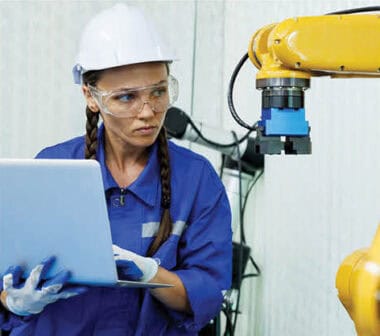
Understanding their place on the digital journey will enable leaders to identify issues, pinpoint where to improve, and keep pace with technology’s fast expanding capabilities.
But, at the same time, it means having one eye on the future – what the long-term impact of Industry 4.0 on the organization will be. How will it change their risk management, for example? Where are they going with automation? How will technologies like AI and machine learning fit in? And what skills do they need to train and recruit their workforce?
As Rao says, “A dualistic strategy responds to the core operational challenges of today while also preparing manufacturers to answer the key strategic questions of tomorrow.”
Evolving to Lean 4.0
Equally important is firms’ willingness to evolve past the lean operating principles that have traditionally defined the industry. Efficiency and effectiveness will still be foundational to competitiveness, but this is no longer about achieving only highly repeatable processes, lowest cost and least time.
Instead, firms must balance cost and process optimization with the need to improve safety, resilience and quality. This requires investment in better data integration to feed developing technology and sharpen decision-making, as well as deep knowledge of the people and processes across different production facilities. Where these vary, leaders who are seeking to scale at an enterprise level must look beyond centrally controlled pilot programs and rollouts, favoring a more nuanced testing and implementation approach across individual plants.
This all intermingles with Rao’s dualistic approach too. By recognizing and understanding where they’re currently delivering on their digital journey, along with where they’re not, firms can move quicker to embed technologies that fill current performance and productivity gaps and deliver value in the future. Specifically, it means:
- Maximizing what they already have, ensuring that they have the right culture, processes and skills to fully harness their existing technologies.
- Experimenting and adapting to move forward, testing novel solutions firmwide and plant by plant to unlock efficiencies, boost resilience and improve customer experiences.
- Collaborating to scale, partnering with stakeholders across the organization itself and, where appropriate, within its broader ecosystem to scale solutions for enterprise impact.
A Woman’s World?
There is another notable intersection here too. While manufacturing remains male-dominated, there is quantifiable progress in attracting female workers to the industry. Right now, 30% of manufacturing jobs are currently filled by women. It’s important for this to be improved to keep pace with other industries. After all, 47% of the overall U.S. workforce is female.
Emerging tech can play a key role in doing so, attracting a new generation of women into manufacturing. Rather than project the physical, labor-intensive image of the past, firms can now offer female workers a vision of creativity, collaboration, and innovation, all rooted in a digitally enabled future, encompassing everything from the smarter use of data to the responsible deployment of AI.

Efficiency and effectiveness will still be foundational to competitiveness, but it’s no longer about achieving only highly repeatable processes, lowest cost and least time.
In other words, manufacturing stands on the brink of not one, but two, revolutions at the same time. As the industry’s digitalization accelerates, the profile of the workforce will rapidly recalibrate too. Fresh skills and perspectives will join advanced technologies in creating smarter factories; more actionable insights on products, quality and risks; more accurate forecasting; and more resilient supply chains.
Ultimately, these twin forces could mean that manufacturers find themselves better prepared to sense and respond to all dynamics of an ever-shifting market. After a decade of challenges, a new and exciting future is emerging. M
About the author:

Lisa Caldwell is EY Americas Business Consulting Leader.
The views reflected in this article are the views of the author and do not necessarily represent the views of Ernst & Young LLP or other members of the global EY organization.
A Pioneer in Automation Becomes a Champion for Digital Transformation
Rockwell Automation’s history points to a pioneering drive to make machines smarter. From its 1903 founding as the Compression Rheostat Company, soon to be renamed the Allen-Bradley Company, the company started with an early prototype machine controller and 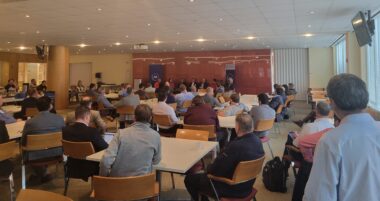 is now a world leader in digital transformation – both for its own operations and in offering guidance for its customers. Today, Rockwell is a $9 billion company with nearly 29,000 employees serving customers in 100 countries.
is now a world leader in digital transformation – both for its own operations and in offering guidance for its customers. Today, Rockwell is a $9 billion company with nearly 29,000 employees serving customers in 100 countries.
In early April, a group of Manufacturing Leadership Council members toured Rockwell’s electronic assembly plant in Twinsburg, Ohio, just outside of Cleveland. The theme of the tour was “Build a Digital Transformation Culture with MES and IoT Technology.” The 250,000-square-foot Twinsburg plant is one of four main electronic assembly locations within Rockwell that provide printed circuit board assemblies that go into the company’s products, with Twinsburg’s eight surface mount technology lines placing three million components and forming 11 million solder joints to make 3,000 control panels each day.
Rockwell’s manufacturing operations is regarded by many as a role model for system integration and data analytics. The company monitors and integrates its engineering data, material management data, product error proofing and genealogy, machine data, quality data, waste data, and performance data. Data is delivered to where it is most relevant and impactful, from facility performance to team leaders down to the specific work order and line performance for operators.
The company utilizes its FactoryTalk production system, industrial automation software that was developed to streamline processes while improving precision and reducing errors. It creates an interactive platform that can integrate data visualization, data collection and analysis, process design, and system diagnostics. Rockwell offers a full suite of FactoryTalk products, including for analytics and data management, product and process design, human-machine interface, industrial communications, maintenance, performance monitoring, and more.
Additionally, Rockwell utilizes a closed loop operating system that combines scheduling and constraint management, and automatically enforces finite capacity based on, for example, the number of operators available at the plant on a given day. Company leaders say this system has helped to eliminate some of its functional siloes, as its development was collaborative and cross-functional, with many different teams giving input to create a tool that could benefit all. While FactoryTalk is already available for manufacturers to license at their own facilities, Rockwell has an eye toward commercializing its closed loop operating system as well.
The tour didn’t shy away from showing both Rockwell’s tried-and-true technologies in addition to its newer ones, including a robot for final testing and assembly that utilizes a digital twin and AR to train operators and maintenance technicians. The machine is being used to create robot standards that can be scaled elsewhere throughout its other manufacturing facilities. At the time of the tour, it had been on the factory floor for less than eight weeks.
When Rockwell’s operations leaders were asked the top reasons for starting their digital transformation journey, they mentioned a need to address a huge uptick in demand, high turnover in the workforce that has led to far less tribal knowledge among frontline operators, and a desire to improve constraint management – both identifying and resolving those constraints. Looking toward the future, the company wants to capitalize on the momentum it has established on its digital transformation journey, explore the opportunities presented by AI and generative AI, and operate on the basis of real-time data-driven decisions.
Rockwell’s leaders also pointed to culture as key to getting functions and teams to work together while moving forward on technology transformation. When it comes to dealing with the complexity created by working with multiple layers of software, they think of it the same way as they do when developing their own products – take things that are sophisticated and make them easy to use by designing them for an operational environment.
Never one to shy from innovation, Rockwell is looking to an exciting future of possibilities ranging from developing large language learning models for manufacturing to building industrial ecosystems to creating a comprehensive data loop that moves between customers, engineering, and manufacturing. It seems fitting for a company that has placed itself as a cutting-edge leader from the radio age to the space age to the data age.
Read a full interview with Rockwell CEO Blake Moret here.
2024 Manufacturing Leadership Award Finalists Recognized for Achievements in Smart Factories, Sustainability, AI and More
June 5 gala will recognize companies and individuals that are leading digital manufacturing transformation
Washington, D.C. – The Manufacturing Leadership Council, the digital transformation division of the National Association of Manufacturers, today revealed the list of world-class manufacturing companies and individual leaders recognized as finalists for the 2024 Manufacturing Leadership Awards, the 20th season of the industry’s premier awards program for achievements in digital manufacturing.
“More than ever, manufacturers are finding that digital technology investment is good for business as they achieve new levels of performance in efficiency, productivity and innovation,” said MLC Founder, Vice President and Executive Director David R. Brousell. “The finalists that we are recognizing for this year’s awards have demonstrated not just the business benefit of Manufacturing 4.0 technology, but also a fresh and imaginative approach to applying it in a transformative way.”
The 2024 awards feature nine project categories to recognize company achievements in the areas of Artificial Intelligence and Machine Learning; Collaborative Ecosystems; Digital Network Connectivity; Digital Supply Chains; Engineering and Production Technology; Enterprise Integration and Technology; Operational Excellence; Sustainability and the Circular Economy; and Transformational Business Cultures. Additionally, individual leaders are recognized in the Digital Transformation Leadership and Next-Generation Leadership categories. Award nominations were judged by a distinguished group of manufacturing leaders from across the industry.
“Each year, we see entries from manufacturers of all sizes, from a wide mix of industries and from locations around the world all telling different versions of the same story: digital is transformational,” said MLC Senior Content Director Penelope Brown, who is head of the awards program. “The quality and sophistication of this year’s award entries were outstanding. Many projects demonstrate how M4.0 investments are positioned for significant business model improvements. Additionally, the individuals recognized in the Digital Transformation Leadership and Next-Generation Leadership categories are exemplary leaders now and for the future.”
Select award winners will present their projects at the MLC’s Rethink Summit, which will take place at the JW Marriott Marco Island Beach Resort in Florida June 2–5. Rethink, also now in its 20th year, is the industry’s leading event for exploring manufacturing’s digital era. Details are available here.
“This year’s program will examine the past, present and future of digital manufacturing, and we are proud that the MLC has had an important role in building a community of leaders and organizations that are leading the charge,” Brousell said. “Whether this is your first time at Rethink or your 15th, you will always come away with new connections, new aspirations and new ideas that you can implement right away.”
All finalists will be recognized onstage at the Manufacturing Leadership Awards Gala, following the Rethink Summit, on Wednesday, June 5, at 7:00 p.m. EDT. Also to be announced at the gala will be category winners for all project and individual categories, winners of the Manufacturing in 2030 Award, the Manufacturing Leader of the Year, the Small/Medium Enterprise Manufacturer of the Year and the Large Enterprise Manufacturer of the Year. See a complete list of finalists here.
Nominations for the 2025 Manufacturing Leadership Awards will open in September.
-MLC-
Founded in 2008 and now a division of the National Association of Manufacturers, the Manufacturing Leadership Council’s mission is to help manufacturing companies transition to the digital model of manufacturing by focusing on the technological, organizational and leadership dimensions of change. With more than 2,500 senior-level members from many of the world’s leading manufacturing companies, the MLC focuses on the intersection of advanced digital technologies and the business, identifying growth and improvement opportunities in the operation, organization and leadership of manufacturing enterprises as they pursue their journeys to Manufacturing 4.0.
MLC Announces Manufacturing Leadership Award Finalists
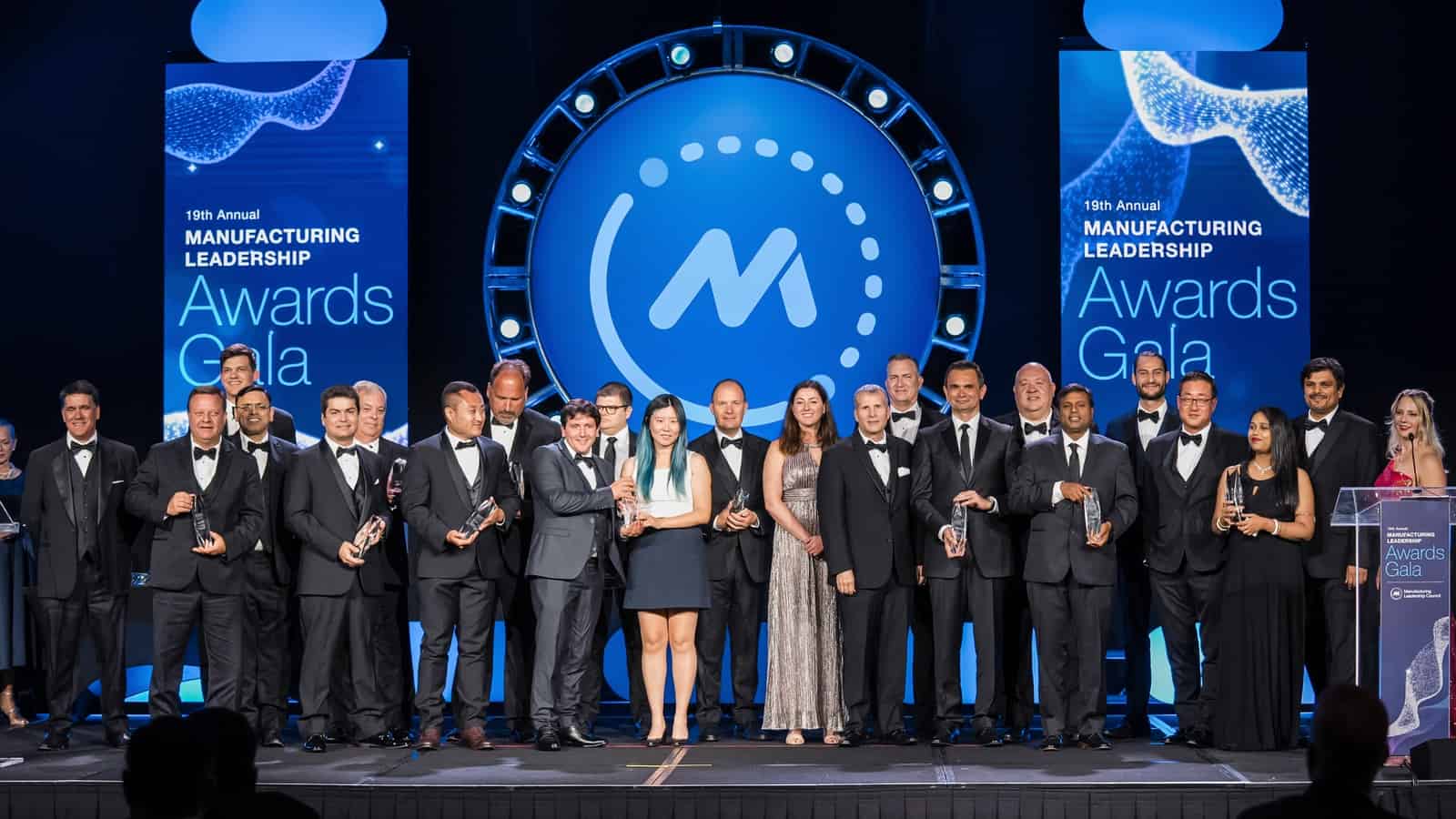
The Manufacturing Leadership Council, the NAM’s digital transformation division, has announced the 2024 Manufacturing Leadership Awards finalists.
About the awards: Now in their 20th season, the Manufacturing Leadership Awards honor the most outstanding manufacturing companies and their leaders for groundbreaking use of advanced manufacturing technology.
- This year’s program features nine project categories, including Artificial Intelligence and Machine Learning, Digital Supply Chains and Sustainability and the Circular Economy.
- It also includes two categories for individuals: Digital Transformation Leadership for executive-level manufacturing leaders and Next-Generation Leadership for up-and-coming leaders age 30 and under.
How we decide: Nominations are judged by an outside panel of digital manufacturing experts with deep industry knowledge and experience.
- For project entries, judges assess an initiative’s effect on improving manufacturing processes, furthering business goals and advancing company strategy, as well as how much digital technology the project used.
- For individual nominations, judges look at each person’s impact both inside and outside their organization, and whether they meet the criteria as a role model for other manufacturing leaders.
Celebration and ceremony: Winners for both of these categories will be announced at the Manufacturing Leadership Awards Gala on June 5 at the JW Marriott Marco Island Beach Resort.
- Award finalists will also be recognized, as will winners of the Manufacturing in 2030 Award, the Manufacturing Leader of the Year, the Small/Medium Enterprise Manufacturer of the Year and the Large Enterprise Manufacturer of the Year.
- The gala caps off Rethink, the industry’s leading event for accelerating digital transformation. (Rethink also takes place in Marco Island, June 2–5.)
The last word: “More than ever, manufacturers are finding that digital technology investment is good for business as they achieve new levels of performance in efficiency, productivity and innovation,” said MLC Founder, Vice President and Executive Director David R. Brousell.
- “The finalists we are recognizing for this year’s awards have demonstrated not just the business benefit of Manufacturing 4.0 technology, but also a fresh and imaginative approach to applying it in a transformative way.”
Welcome New Members of the MLC April 2024
Introducing the latest new members to the Manufacturing Leadership Council


Philippe Adam
CMO
aPriori
![]()
www.apriori.com
![]()
https://www.linkedin.com/in/philippeadam1/

Kevin Carpenter
Chief Supply Chain Officer
Toro

www.toro.com
![]()
https://www.linkedin.com/in/kncarpenter/

Rob Harlow
Senior Manager, NA Production Engineering & Automation R&D
DENSO
![]()
https://www.denso.com/us-ca/en/
![]()
https://www.linkedin.com/in/rob-harlow-b1b55887/

Brad Larson
Director of Manufacturing
Fey Industries, Inc.
![]()
https://www.feyindustries.com/
![]()
https://www.linkedin.com/in/brad-larson-3b4b63145/

Pete Millett
Director – Global Engineering and Manufacturing Director
Lubrizol

www.lubrizol.com
![]()
https://www.linkedin.com/in/pete-millett-0ab50711/

Lion Moeliono
Global Manager, Digital Manufacturing Transformation & Innovation
Rockwell Automation
https://www.rockwellautomation.com/en-us.html
![]()
https://www.linkedin.com/in/lion-moeliono-0058752/

Raja Shembekar
Vice President Manufacturing & Corporate Officer
PACCAR

https://www.paccar.com/
![]()
https://www.linkedin.com/in/raja-shembekar-06934ba8/

Balthazar Moncada
Director of Operations | COO
HELVEX

https://www.helvexusa.com/
![]()
https://www.linkedin.com/in/baltazar-moncada-rodriguez/

Hugo Alberto Gomez Sierra
CEO
Condumex
https://condumexinc.com/
![]()
https://www.linkedin.com/in/hugo-gomez-a2370011/
The Road to Digitalization: Evaluating Readiness for Digital Transformation
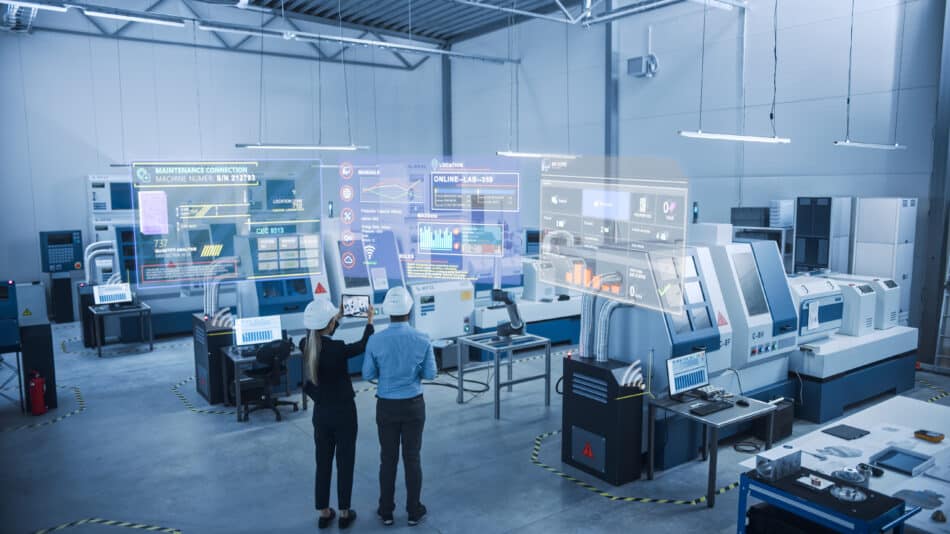
Manufacturers should employ a comprehensive assessment framework to identify strategic actions required to achieve a higher level of digital maturity.
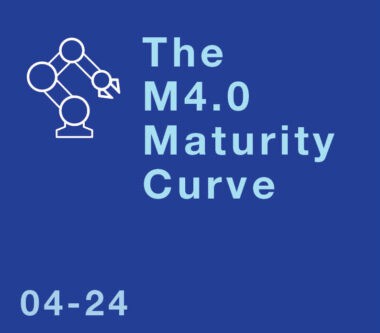
TAKEAWAYS:
● Manufacturers that stand still run the risk of falling behind.
● The insights are in the data, fueling the continuous improvement cycle, where each step reveals new opportunities for innovation and optimization.
● Measuring digital maturity is the catalyst for the transformative process.
The fourth industrial revolution has driven the manufacturing industry to an inflection point where technological advancements are no longer just accelerators for growth but fundamental for organizational survival. This digital shift is not merely about adopting new technologies—rather it is about realizing a profound change in how organizations operate, innovate, and deliver value. As leadership focuses on finding a strategic balance between technological advancements to realize quick, tangible benefits while maintaining the flexibility to scale operations in an increasingly complex environment, one thing remains constant—namely, the insights are in the data and the ability to assess an organization’s preparedness for digitalization is paramount for success.
Redefining Readiness: A Fresh Perspective to Drive Transformation Differently
Of the many manufacturers that have started their digital transformation journey, relatively few have realized the value they aimed to achieve, often because they are simply starting in the wrong place. Building the future factory involves visionary leadership and practicality, beyond just adopting new technologies for quick changes. Leaders must envision their organization’s future, not by predicting technologies, but by understanding industry directions, their starting point, and the competitive path forward. This intersection of industry trends, current state, and defined organizational objectives, gives birth to an organization’s unique digitalization strategy—underscoring digital readiness and representing a holistic approach that integrates the technological, cultural, and operational facets of an organization to derive true digital value.
A McKinsey & Company study highlights the significance of digital readiness and understanding one’s digital maturity and indicates that companies that excel in their digital transformation efforts are twice as likely to report double-digit growth rates compared to their less-prepared counterparts (McKinsey 2020). But, with their enthusiasm for technology adoption and their emphasis on strategic planning, many manufacturers overlook assessing digital maturity and the readiness of current systems to integrate with new technologies.
Digital maturity denotes the sophistication with which an organization incorporates digital technologies and methodologies across its operational frameworks, customer engagement strategies, and innovation initiatives. This concept evaluates several dimensions, including the automation level and digitization depth of core business workflows, the strategic application of data analytics for enhanced decision-making processes, and the comprehensive integration of advanced digital technologies such as robotics, artificial intelligence (AI), and the Internet of Things (IoT) within the enterprise ecosystem.
“A digitally mature enterprise can be characterized by its advanced integration of technology across all facets of its operations.”
Through this rigorous exercise, leaders can identify the most critical technologies and processes that will provide the quick win, tackle the most prominent operational deficits, drive alignment of their operational goals, and serve as a foundation for future scalability. Using this information as a baseline, you can shape your digital transformation strategy from a simple shopping list of the latest technologies and transform it into a more comprehensive road map that addresses the gaps and leverages the existing strengths of existing operations.
Digital Mastery: Key Indicators of an Advanced Organization
In its 2023 Manufacturing Horizon Report, CRB revealed that companies effectively integrating the right technologies with their operational dynamics have experienced a surge in productivity by an astounding 27 percent, and a subsequent reduction in operational costs by nearly 19 percent. A study by Deloitte shows companies at the highest level of digital maturity are 26 percent more profitable than their industry averages.
A digitally mature enterprise can be characterized by its advanced integration of technology across all facets of its operations. From strategic decision-making to day-to-day processes, such organizations leverage digital tools and platforms to enhance productivity, foster innovation, and deliver superior customer experiences. Central to their operational model is the use of data analytics and AI to drive business insights, ensuring agility and responsiveness to market changes while simultaneously prioritizing cybersecurity and data privacy, embedding these considerations into their technology architecture and everyday business practices.
But digital maturity is not just about technology adoption, it’s about transforming organizational behaviors and business models so they can thrive in the digital age (Deloitte 2020; McKinsey & Company 2021). In these organizations, essential operations are no longer confined to isolated departmental units—rather they are developed and overseen by interdisciplinary, production-focused teams with well-defined performance standards and business objectives. The most technologically advanced organizations possess the infrastructure to facilitate comprehensive platform-based procedures, bolstered by self-sufficient resources at the forefront. These cross-functional teams are at the core of cultivating the next generation of manufacturing culture: they consistently provide scalable, technology-led solutions, products, or client experiences, fueled by a continuous cycle of learning and innovation that stimulates regular advancements and enabling them to adapt swiftly to evolving client expectations. and driving their competitive edge.
From Traditional to Transformed: The Path to Digital Maturity in Manufacturing
Navigating the intricate journey towards digital maturity requires a sophisticated understanding of the evolutionary stages that manufacturing entities must traverse. Leading industry consultants have highlighted delineated frameworks that categorize such progression within manufacturing environments. While each has their own interpretation, these stages, broadly outlined, transition from initial digital awareness, where the digital strategy is nascent and fragmented, through to a fully integrated digital ecosystem, characterized by advanced analytics, IoT implementation, and AI applications. This progression encapsulates a journey from foundational digital capabilities towards a transformative state, where digital technologies are leveraged not just for incremental improvements but are deeply embedded into the fabric of operational processes and strategic visions, driving innovation, efficiency, and competitive advantage in a connected, smart manufacturing landscape.
“Navigating the intricate journey towards digital maturity requires a sophisticated understanding of the evolutionary stages that manufacturing entities must traverse.”
Coupled with such widely recognized industry knowledge, our real-world experience has driven the creation of a digital maturity methodology that emphasizes a people-first, technology-enabled approach, focusing on the strategic deployment of technology to deliver real business value. By identifying areas for maturity enhancement within organizational and technological domains (OT/IT), we facilitate the transition towards a fully optimized manufacturing solution. Central to our process are six key technology pillars that support digital manufacturing advancements, employing an iterative transformation lifecycle that incorporates analysis and feedback after each phase to refine processes and improve data collection (Figure 1). This ensures a continuous loop of improvement and adaptation, aligning technology implementation with human insight and collaborative engagement.
Figure 1: The path to digital maturity

Metrics of Modernization: Maturity and Momentum
Quantifying an organization’s digital maturity involves a systematic approach. This approach includes evaluating the integration and effectiveness of existing digitization across all business units and providing leaders with a clear understanding of their current position in their digital transformation journey, while simultaneously outlining the path toward achieving higher levels of technological integration and operational efficiency. This multi-dimensional assessment includes an analysis of several key factors: digital strategy formulation, leadership commitment towards digital initiatives, operational agility for adopting new technologies, the level of client engagement through the digital ecosystem, and the empowerment of the workforce with digital tools and skills. This measurement not only benchmarks an organization’s current capabilities against industry standards and best practices, it also identifies gaps and areas for improvement, facilitating targeted investments in technology, processes, and workforce development, strategically allocating resources for digital growth. Ultimately, the measurement accelerates an organization’s transformation into future-proof, digitally mature enterprises that are more competitive, thereby fostering a culture of digital excellence that is adaptive in the rapidly evolving digital landscape.
While many recognize that the ability to measure maturity is a powerful catalyst for change, it can be challenging to successfully quantify relevant insights. From a broad perspective, effective metrics to provide granular insight into three specific dimensions of transformation:
Technology:
- Overall equipment effectiveness is a critical metric for measuring manufacturing efficiency, combining performance, availability, and quality.
- Percentage of connected assets: Quantify the scale of IoT implementation, the degree of automation, and the existing adoption of advanced technologies.
- Data capture rate: Measure the breadth of real-time data collection for analytics.
Process:
- Data-driven decision-making capabilities in production, planning and scheduling, inventory management, and integrated supply chain management. This includes examining lead times and cycle times to track gains in agility and responsiveness; evaluating inventory turnover ratio to measure supply chain optimization and risk reduction; and studying first-pass yield to track improvements in quality control aided by data analytics.
- Workflow optimization for efficiency and agility.
Organization:
- Leadership commitment to digital transformation and strategic alignment, including a digital skills index to evaluate workforce digital literacy.
- Cross-functional collaboration enabled by technology platforms that quantify cross-functional project success rates and collaboration effectiveness.
- Cybersecurity, data governance, and risk management protocols in place to expose vulnerabilities or inadequate practices, including cybersecurity Posture Assessment
Organizations can adopt various frameworks and/or maturity models to systematically evaluate and benchmark their digital progress against parameters, enabling a structured roadmap for digital advancement. We highlight several frameworks organizations could use for a structured assessment approach:
- Smart Industry Readiness Index (SIRI): EDB’s framework provides a rigorous 16-dimension assessment. The Prioritization Matrix (TIER) facilitates targeted action based on today’s state, impact to the bottom line, essential business objectives, and references to the broader community.
- Acatech Industrie 4.0 Maturity Index: This model uses a stage-based approach to help organizations chart their maturity progression and define their developmental trajectory.
- Digital Maturity Models (Deloitte, BCG, CESMII, etc.): These consultancy frameworks offer broader enterprise-level assessments, aiding strategic alignment.
In my experience, the journey to digital maturity demands an honest assessment of your organization’s current standing. By adopting any of the proven frameworks and critically analyzing the data, manufacturing leaders gain a diagnostic blueprint for targeted action. This process uncovers the specific investments in technology, process optimization, and workforce development that will yield the highest return, transforming the framework from a mere scorecard into an instrument of strategic change by creating the business case for your continuous improvement initiatives.
Charting the Course: Evaluating Progress Towards Digital Excellence
Given the dynamic ecosystem of the manufacturing industry—characterized by fluctuating demand, raw material availability, and geopolitical uncertainties—the ability to effectively scale a technology strategy and advance your digital maturity is tantamount to achieving operational agility and sustained growth. Scaling is not merely a replication of solutions that have demonstrated value in a small-scale setting; it is an intricately planned endeavor that aligns technology with business objectives, regulatory frameworks, and workforce capabilities. Contrary to popular belief, it does not merely refer to deploying more of the same technology across an enterprise. It involves understanding the contextual intricacies of each operational environment and adapting the foundational strategy to the idiosyncrasies accordingly.
“By strategically leveraging assessment frameworks and focusing on actionable insights, manufacturing leaders gain a powerful tool for continuous improvement.”
For instance, a mid-sized automotive supplier improved operations by using a digital maturity assessment, which identified a gap in data analytics. By investing in IoT sensors and cloud analytics, they reduced downtime by 15 percent, improved efficiency by 8 percent, and fostered a proactive maintenance culture. Similarly, a large food and beverage company enhanced its complex supply chain visibility and efficiency through a maturity assessment, adopting cloud and IoT technologies to improve delivery rates, reduce inventory costs, and ensure food safety. These examples underscore the value of data-driven decisions and targeted strategies in driving continuous improvement, innovation, and resilience against technological disruptions and evolving market demands, highlighting the importance of a culture of innovation integrated into operational practices.
This path toward digital maturity is an ongoing journey, not a single destination. The importance of understanding where to begin extends beyond the immediate advantages of implementing technology, nurturing a manufacturing sector that is both resilient and visionary. By strategically leveraging assessment frameworks and focusing on actionable insights, manufacturing leaders gain a powerful tool for continuous improvement. This approach equips organizations with the capability to adeptly confront the challenges and seize the opportunities that emerge in the digital era, driving their long-term competitiveness and adaptability, purposely and efficiently. The ultimate reward, however, lies not just in achieving a higher maturity score, but in building a manufacturing enterprise that will thrive in the dynamic industrial ecosystem.
About the author:

Holly Becker is director of Commercialization at ATS Applied Tech Systems, LLC.
For Manufacturers, Digital Maturity Hasn’t Yet Come of Age

Manufacturers are at an early stage of understanding how far advanced they are with Manufacturing 4.0, as they grapple with linking digital strategy to business strategy, cultural and organizational issues, and leadership development challenges.

KEY TAKEAWAYS:
● A majority of manufacturers either do not have a formal process for digital maturity or do informal benchmarking.
● A majority of manufacturers have a digital maturity target of Manual Execution with Digital Support, with an equal balance of companies feeling like they are on track or behind schedule.
● Digital strategy, in general, is still poorly integrated with overall business strategy, capital strategy, supplier decisions, and M&A strategy yet remains vital towards future competitiveness.
As companies continue to share feedback that they are either not seeing value from digital transformations or are feeling like they are behind schedule, MLC fielded a new survey to understand how companies are managing digital maturity. Having clear criteria for success is important for any transformation journey, and the survey results show that manufacturers are just starting to put in place formal metrics for assessing their maturity.
Manufacturers continue to focus on building the core foundation of Manufacturing 4.0 through technology investments and workforce development. However, in order to become digitally mature, what’s required is a deeper integration of Manufacturing 4.0 with the rest of manufacturers’ business processes. Additionally, to overcome the cultural barriers facing digital transformation, leadership teams need to be more committed to their own development and active engagement in this change.
Section 1: Measuring Digital Maturity
Measurements of digital maturity are not yet universally defined, which leads to variation in how companies understand their current maturity level. Currently, roughly 10% of manufacturers (across both SMM and large companies) do a formal external assessment against some sort of defined standard. Roughly 30% (again, for both SMM and large) do external benchmarking. With regards to internal assessments, however, there is a significant difference, with roughly 46% of large manufacturer respondents doing internal assessments across factories. Most large manufacturers that conduct any sort of assessment do so through a combination of assessments, while most SMMs do only one type of assessment. Overall, however, roughly 50% of total respondents do not have any formal process by which maturity is assessed.
This lack of a formal process is validated by the frequency in which assessments are done. For SMMs, the majority of companies that do assessments do so once a year or less. For large manufacturers, it is roughly split between ongoing assessments and once a year or less.
Finally, there is a difference in the business metrics that align with digital maturity. For SMMs, the focus is on customer and employees (on-time delivery, product quality, and employee satisfaction are in the top 5), while large manufacturers are focused on traditional operational metrics (cost savings, OEE, and productivity are in the top 5).
1. Digital Maturity is Still a Feeling vs. a Quantifiable Metric
Q: How does your company measure digital maturity?

2. Few Link Maturity Measurements to Formal Planning Cycles
Q: How often do you measure digital maturity

3. SMMs Leverage Customer and Employee KPIs, While Large Firms Rely on Traditional Operational Metrics
Q: What business KPIs are used specifically to measure digital maturity?

When looking across various aspects of the business, survey results show consistency between SMM and large manufacturers when it comes to digital maturity target, progress, and peer competitiveness. The digital maturity targets for operations and supply chain reflect normal distributions, centered around a level 2 – manual execution with digital support. For maintenance, product development, and workforce development, the results indicate left-centered distributions, with more companies targeting lower maturity levels than for operations or supply chain.
Digital progress versus target is relatively consistent across all processes, with an even distribution between on-track and behind schedule. The biggest gap in progress is around workforce development.
Finally, when comparing to peers, survey respondents indicate a difference in perception, especially around operations, with 23% of respondents feeling they are ahead of their peers. As with their internal view of progress, the area where companies feel they are further behind their peers is around workforce development.
4. Digital Maturity Targets Reflect the Challenges of Transformation
Q: How would you assess you digital maturity TARGET?

5. Project Success Guides Progress
Q: How would you assess your digital maturity LEVEL vs. TARGET?

6. Peer Assessments a Mixed Bag
Q: How would you assess your digital maturity vs. your PEERS?

Section 2: Digital, Business Strategy Integration Lacking
When looking at how digital transformation strategy is integrated with other business strategies, there is quite a bit of variability, with the weighted average relatively low. On a scale of 0-10 (with 10 being highly integrated), the survey results peg overall business strategy and capital investment strategy at ~3.3. The integration with M&A, partnerships, and supplier decisions is less at ~2.5. However, the overall importance of digital maturity towards future competitiveness is ~4.7.
This validates the need for integration of digital projects in all aspects of the business as critical for digital maturity growth.
7.Strong Influence of Digital Maturity on Competitiveness
Q: How well does your smart factory strategy integrate / influence the following?
1 (low integration / importance) – 10 (high integration / importance)

Section 3: A Need for Greater Leadership Knowledge
Leadership plays a critical role in corporate culture. As culture continues to be identified as a key driver for digital transformation success, the data demonstrates a validation of the need to continue to focus on developing leadership knowledge and skills with the same rigor as front-line workers. Two-thirds of respondents feel that leaders are knowledgeable about Manufacturing 4.0 but are in need of external guidance to effectively lead transformation efforts. Additionally, 20% are uninformed and in need of significant support. What was interesting in the results is that C-suite leaders who responded ranked themselves as less informed than other respondents. This awareness is an important step towards improving their knowledge and skills.
An important step in developing their skills and knowledge is to incorporate Manufacturing 4.0 topics into their regular learning and development program. Only 20% of respondents felt that this currently in place, while over 60% felt learning was either ad-hoc or nonexistent.
These findings are further validated when looking at the roadblocks to improving digital maturity. Organization structure / culture that resists change and leadership digital acumen, along with a skilled workforce and leadership buy-in, were listed as top barriers for both SMM and large manufacturers.
Where a delta was seen in roadblocks (although all of these items were important) was large manufacturers identifying data and systems integration as critical and SMM companies identifying investments / access to budgets and an M4.0 roadmap as critical. M
8. Greater Leadership Learning Needed
Q: Digital acumen of company’s senior leadership team.

9. M4.0 Needs to Be Embedded in Formal L&D Programs
Q: How often does the senior leadership team engage in active learning around digital transformation?

10. Organizational Structure, Culture Remain Top Roadblocks
Q: What do you feel are your company’s primary roadblocks to improving your digital maturity?

About the author:

Steven Moskowitz, Ph.D., is the Senior Director, Event Content at the Manufacturing Leadership Council.
GenAI Ushers Human-Like Intelligence in Manufacturing

Catalyzing Digital Maturity with Generative AI: Democratizing Data Analysis, Automation, and Problem-Solving in Manufacturing

TAKEAWAYS:
● Generative AI stands as a transformative technology poised to democratize data analysis, reasoning, and automation throughout the manufacturing industry’s value chain.
● Leveraging Retrieval Augmented Generation to enhance foundational models represents an optimal technique for beginning to harness GenAI’s value.
● Manufacturers should evaluate digital maturity and initiate pilot-testing applications to identify high-impact, feasible business challenges while establishing an interconnected and contextualized data foundation.
The AI Wave in the Manufacturing Industry
The AI wave, and specifically, Generative AI (GenAI), is poised to disrupt manufacturing. GenAI’s greatest strength lays in democratizing the power of data analysis and automation through a reasoning engine and a natural language interface. A 2023 BCG survey of 1,800 manufacturing executives found that GenAI is the technology with the most disruptive potential1. With the power of large data analysis, manufacturers can optimize value systematically and dynamically — a feat of “mission impossible” proportions today.
AI Categories and Capabilities

Figure 1: AI Types and Capabilities
In the last few years, classical machine learning has been broadly implemented in manufacturing to predict machine failures, classify defects, identify process outliers in machine behavior and product quality, and even to autonomously adjust machine parameters to optimize quality and throughput. While classical machine learning has been a staple, the exploration and implementation of GenAI’s capabilities in this sector are just beginning to unfold. Both classical machine learning and GenAI are valuable for different reasons. GenAI revolutionizes data analytics by pre-training on vast unstructured datasets, making it possible to alter the way that prediction, classification, and clustering are calculated in classical machine learning models. Meanwhile, GenAI’s natural language processing and code generation/interpretation capabilities allow business professionals to access complex data analysis without needing programing or data science expertise. The development of multimodal foundation models is unlocking capabilities to turn not only text but also audio, images, and video into dynamically generated insights in the hands of frontline workers. Mexican workers can benefit from the problem-solving experiences of their Asian and Polish counterparts, aided by an intelligent agent that offers summarized solutions and specific action recommendations based on insights from these regions. Industrial engineers can scan the timetable or Standard Operating Procedures (SOP) on paper to generate digital SOP and work instructions and associate them with the product and process design.
AI and Generative AI Use Cases for Manufacturing
GenAI’s adoption will democratize access to vast reservoirs of structured and unstructured knowledge bases, enable large-scale data analysis, and provide powerful reasoning engines and complex problem-solving capabilities to all individuals, regardless of their technical background. Ultimately, manufacturers can use these capabilities to mimic the adaptive problem-solving capabilities of humans, by learning behavioral patterns from past human and machine experiences. Gartner refers to this as Actionable AI and sees it as one of the top innovative technology trends for manufacturing operations leaders4.
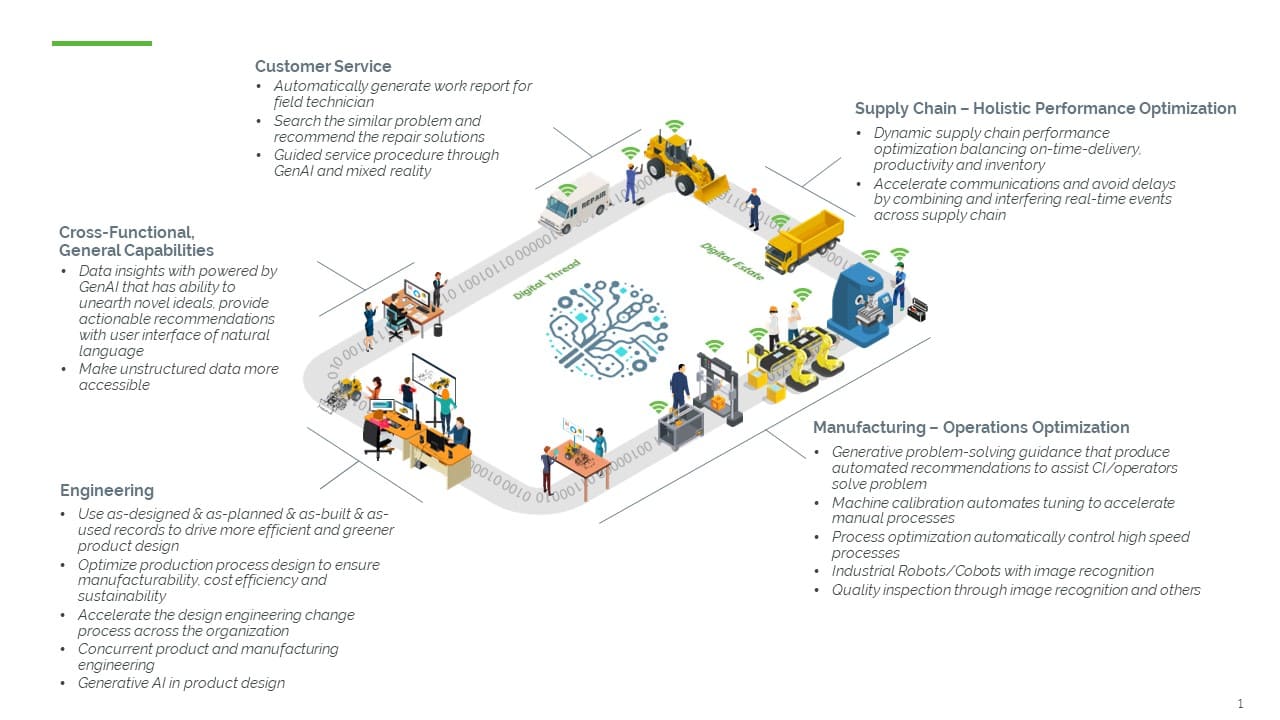
Figure 2: Classical ML and Generative AI use cases across value chain2
Data Insights: Empowering the Entire Value Chain
From engineers to shop floor personnel, GenAI is revolutionizing data analysis. It scales insights from both internal and external, particularly unstructured, data sources — enriching advanced analytics with foundational model-generated insights. GenAI’s true innovation in data insights lies in its ability to unearth novel ideas, offer an unlimited scope to dissect data from multiple perspectives, and provide actionable recommendations — not just diagnostics — all in real-time.
Operations Optimization: A New Paradigm for Operations Leaders, Frontline Workers, and Continuous Improvement (CI) Leader
GenAI introduces closed-loop asset optimization by supplementing programmable logic controller (PLC) inputs with a broader spectrum of data points like vibrations, temperature, and pressure (typically captured from IoT sensors). As a result, operations leaders can leverage GenAI to pinpoint machine optimization opportunities. Furthermore, frontline workers and continuous improvement leaders can consult GenAI systems for advice on specific operational challenges — eliminate bottleneck and non-value-added activities — transforming GenAI into a ubiquitous and invaluable partner in continuous improvement.
Product and Process Design Optimization: For Innovative Product and Manufacturing Engineers
In addition to generative design, product engineers can utilize GenAI for product design by integrating multifaceted data from as-designed and as-built and as-used records, leading to smarter and more efficient design choices. Manufacturing engineers can employ GenAI for process design optimization, ensuring that manufacturability, cost-efficiency, and sustainability are embedded at the very heart of production processes. Through GenAI, design principles are not just informed by data but are fundamentally driven by the most advanced insights available. GenAI can also help accelerate the collaboration and engineering change process across the organization by leveraging contextual information from otherwise untapped information sources like historical paper-based designs, and by securing inputs from a globally distributed design team in their natural languages.
Holistic Performance Optimization: Strategizing for Supply Chain and Operations Leaders
Supply chain and operations leaders have long grappled with the complex challenge of dynamic performance management, balancing safety, quality, delivery, productivity, and inventory. GenAI excels in parsing large, complex, and interlinked datasets, learning from historical patterns to offer insights and recommendations for emerging issues, equipping leaders with a robust tool for strategic decision-making. By combing real-time updates (both internal and external; for example, weather and frequently changing geo-political landscape) and inferring the impact to shipment updates as communicated via email from suppliers, GenAI copilots can accelerate communication across the supply chain thereby shortening delays and making the operations more responsive and resilient.
The Approach for GenAI in Manufacturing
In theory, industrial companies can approach Generative AI in three ways: training their proprietary foundation model, fine-tuning an existing foundation model, or enhancing an existing model via prompt engineering and Retrieval Augmented Generation (RAG). Prompt engineering refers to the process of designing, refining, and optimizing input prompts to guide a generative AI model toward producing desired outputs3. RAG is an architecture that augments the capabilities of a Large Language Model (LLM) by adding an information retrieval system that provides grounding data. In practice, training proprietary models and fine-turning foundation models are both resource intensive and can quickly run up costs in the of tens of millions of dollars — leaving most manufacturers with very unclear ROI. RAG alongside prompt engineering is the least expensive and quickest method. It also offers greater transparency as it can refer to sources, making it an ideal starting point for companies looking to explore GenAI technology and validate use cases.
With foundational models and RAG frameworks improving with strong reasoning capabilities and tools, we can expect the adoption of GenAI to scale quickly — roles across the value chain will be enabled by one or multiple copilots. In fact, the simplest RAG application can be built with as little as “five lines of code”5. However, regardless of the techniques used, GenAI outputs are only as good and reliable as their inputs — a contextualized, interconnected data foundation is critical. The adage, “garbage in, garbage out” still holds true in the GenAI era, and garbage-in can lead to perilous AI inaccuracies. The data foundation needs to allow GenAI applications to understand the context around the data. For example, the OT data from PLCs is usually tag data displaying vibration and temperature but does not have the context of what asset the PLC is in, which plant, line, material, or operation it is associated with.
“The development of multimodal foundation models is unlocking capabilities to turn not only text but also audio, images, and video into dynamically generated insights in the hands of frontline workers.”
Building a GenAI app for product design and manufacturing engineers regarding the optimal manufacturability (cost, quality, and delivery) requires an interconnected data foundation that includes the as-designed, as-planned, as-built, and as-used records of the product through its product life cycle. The opportunity for a product designer to design a better product lies in mining the actual history and experience through data gathered from users, and the IT and OT systems that span the engineering, manufacturing engineering, production execution and field services processes.
Start by Getting Your Data House in Order
Technology is a key pillar in the digital maturity journey, and RAG and prompt engineering are the first steps in understanding how GenAI can impact your business. A GenAI implementation should start with evaluating current digital maturity and focusing on the business outcome, starting small with high impact use cases, followed by an intentional plan to rapidly scale implementation and adoption of validated outcomes. As data privacy and security are top-of-mind in assessing new technologies, it is important to understand the data privacy policies of LLM service providers. From a technical perspective, the most crucial and foundational step is to build a contextualized, interconnected data foundation

Figure 3: Illustrative architecture of applied AI
A four-layer framework illustrates the GenAI data foundation approach:
- The first layer is the hardware computing infrastructure layer.
- The second layer is the data foundation layer, which manages the engineering, operations, supply chain and financial activities and provides the domain-specific data, like real-time engineering and manufacturing information systems (IT), and operational technology (OT) like equipment, sensors, tools, and quality verification systems. This is where ERP, PLM and MES, play a role as the authoritative sources of business data, as well as an IIoT platform like PTC ThingWorx, play a role to get IT, OT and engineering technology data aligned and contextualized.
- The third layer is the AI technology layer and includes machine learning models, GenAI foundation models, orchestration services, etc. Examples of these include Azure OpenAI Service and Microsoft Copilot Studio for AI.
- The fourth layer is the applications layer, where the AI capabilities are applied to solve specific business problems, either as standalone applications or a plug-in of legacy applications.
GenAI represents a transformative opportunity for the manufacturing industry, poised to revolutionize data analysis, automation, and problem solving. Per World Economic Forum, GenAI is expected to add between $2.6 and $4.4 trillion in annual value to the global economy – nearly a quarter of which could be productivity improvements of up to two times and task automations of nearly 70% across manufacturing and supply chain-related activities6. Its potential to empower a wide range of the value chain is immense but realizing this potential hinges on high impact use cases and building a unified, contextualized, interconnected data foundation. We are just beginning to explore GenAI’s vast possibilities. Therefore, we encourage manufacturing companies to pull together a list of your most urgent, impactful business problems that require intensive data collection, validate the feasibility of the AI technology like RAG, and start with building your data foundation leveraging technologies like an IIoT platform and PLM. M
About the Authors:

Amol Adgaonkar is a Senior Director within the Worldwide Manufacturing & Mobility Industry team at Microsoft

Gonzalo Chavez is a Senior Analyst in Market Development, IoT at PTC

Howard Heppelmann is Divisional Vice President and General Manager of PTC’s ThingWorx IoT Solutions business segment

Alex Lemken is the Director of AI and Applied Analytics at PTC

James Zhang is the Vice President of Market Development, IoT at PTC
Appendix
1. BCG, December 2023 https://www.bcg.com/publications/2023/gen-ai-role-in-factory-of-future
2. Microsoft Cloud for Manufacturing, https://www.microsoft.com/en-us/industry/manufacturing/microsoft-cloud-for-manufacturing
3. The economic potential of generative AI. McKinsey. June 2023.
4. Top Innovative Technology Trends for Manufacturing Operations Leaders. Gartner. Nov 2023.
5. https://docs.llamaindex.ai/en/latest/getting_started/starter_example.html. LlamaIndex Starter Example.
6. Global Lighthouse Network: Adopting AI at Speed and Scale. World Economic Forum. Dec 2023